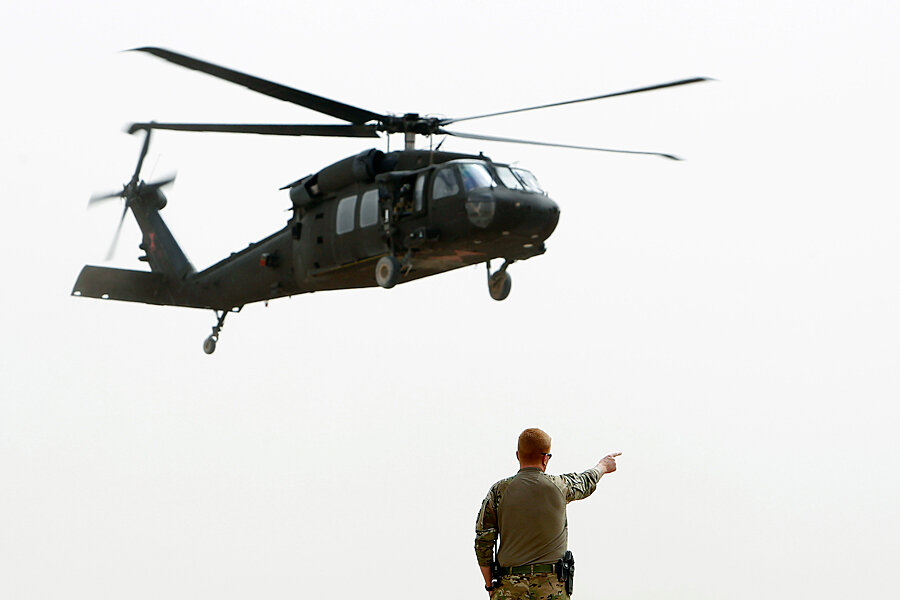Mexico prepping to buy more Black Hawks: settling in for a lengthy fight in drug war?
Loading...
- Sarah Kinosian is a Latin America Program Associate at the DC-based Center for International Policy. The views expressed are the author's own.
The Mexican military has used US-made Sikorsky UH-60 Black Hawk helicopters for years to fight drug traffickers – and now it’s prepared to spend over half a billion to more than double its fleet.
On April 17, the US State Department cleared the way for Mexico to purchase 18 Black Hawk helicopters for $680 million. US Congress now has until May 17 to act if it disagrees with the proposed deal.
The price tag also includes radios, night-vision goggles, training and support services, and dozens of 7.62mm machine guns, to be attached to the sides of the choppers to provide air support for ground attacks.
Mexico has been battling a war against drug trafficking and related violence within its borders for nearly a decade. The move to procure such sophisticated technology like the Black Hawks has some analysts wondering if it's a signal of Mexico’s plans to move toward a more long-term, militarized approach to fighting cartels.
Black Hawks are utility helicopters, used for activities like air assaults, medical evacuations, support for ground attacks, and troop transport. Since 2007, the US State Department has provided a total of 14 helicopters to the Mexican government as part of the security-focused 2008 Mérida Initiative.
“When the US government gave the Mexican government Black Hawks at the beginning of the Mérida Initiative, they were meant for transporting soldiers and police quickly – be it to capture a capo [drug lord] or to respond to a firefight,” says Adam Isacson, a Latin America security expert at the Washington Office on Latin America.
The purchase likely means the Mexican government will increasingly use the helicopters in raids on kingpins and is settling in for a longer fight, according to one US Military helicopter pilot, who asked to remain anonymous. “It’s a versatile, agile, medium size aircraft that can provide air support and … It can also land in tight locations – ideal for keying in on well-armed kingpins,” the pilot says.
Mexico has a “very tiny” helicopter fleet for a country of its size, says Mr. Isacson. And much like insurgents, Mexican cartels rely on mobility to avoid capture and often use military-grade arms and defense tactics, including high-powered weapons and armored vehicles, which the new helicopters could potentially help curb.
Taking cues from Colombia?
Mexico would likely use the new choppers in similar ways as Colombia, which has long battled drug trafficking and rebel violence during its decades-long internal conflict.
Colombia received its first Black Hawk from the United States in 1987. Since then, the South American nation has received several more with US security assistance, mostly under the 2000 security aid package known as “Plan Colombia,” and its later iteration, “Plan Patriota.” Now one of world’s largest operators, with a fleet of 103, Colombia has used them to drop troops into the jungle to attack remote rebel camps while also using them to provide air cover during combat.
“Given the artillery coming with Mexico’s purchase, the government probably has something similar in mind,” says Isacson, referring to more of an offensive approach to tacking security challenges like drug trafficking.
Under current President Enrique Peña Nieto, Mexico's drug war has remained highly militarized, despite campaign promises to move away from the model pushed by former President Felipe Calderón. The road ahead is long for the Mexican government, despite victories like the arrests of high-profile cartel leaders Joaquín “El Chapo” Guzmán and Zetas leader Miguel Angel Treviño Morales, alias Z-40.
US officials have pointed to Mexico’s interest in buying military equipment as a sign of improving military ties, which some say have been strained. Last year President Peña Nieto mandated all contact with US law enforcement go through the Ministry of the Interior, effectively ending US officials’ access to the country’s security agencies. US officials have denied these reports, pointing to the cooperation between the US and Mexican agencies involved in Guzmán’s arrest as evidence of a strengthening relationship.
"This proposed sale will contribute to the foreign policy and national security of the United States by helping to improve the security of a strategic partner. Mexico has been a strong partner in combating organized crime and drug trafficking organizations," the Defense Security Cooperation Agency said this month.
The helicopter deal leverages US expertise to increase engagement between the two militaries, proponents say, and there have been reports that the US is discussing other military sales to Mexico, such as unmanned aerial vehicles, or drones.





